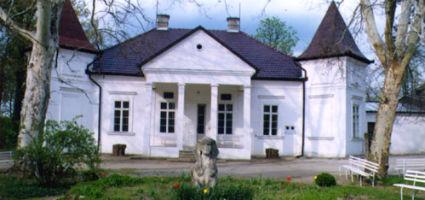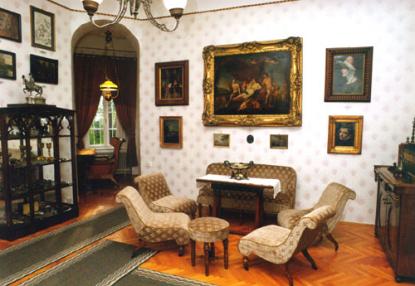2026. January 20. Tuesday
Blaskovich Mansion Museum - Tápiószele
 |
Address: 2766, Tápiószele Múzeum út 13.
Phone number: (53) 380-157
E-mail: blaskovichmuzeum@gmail.com
Opening hours: 28.02-14.11.: Tue-Sun 9-17
15.11-31.01.: Tue-Fri 10-16 |
Museum tickets, service costs:
|
Ticket for adults
|
1200 HUF
|
/ capita
|
|
Ticket for students
|
600 HUF
|
/ capita
|
|
Ticket for pensioners
|
600 HUF
|
/ capita
|
|
Group guide
(15-30 people)
|
6000 HUF
|
/ group
|
|
Group guide for students
|
3000 HUF
|
/ group
|
The permanent exhibition bearing the title "Manison in the 19th century" is unparalleled in the richness of relics belonging to the Hungarian nobility. In the parlour, living-room and study the former way of life seems to come to life.

The first place we enter is the dining room, the walls of which are decorated with trophies, paintings, guns and equipment related to game hunting. The galvanocopy of the Scythian gold deer as well as mineral-, snail- and shell-collections are displayed in this room.
The most beautiful room of the mansion is the empire parlour. The walls are decorated with paintings made by Károly Kisfaludy, Miklós Barabás, Alajos Györgyi Giergl and 17th-18th century Italian, Netherlandish and Austrian painters. The most outstanding of them are Christ on the Cross, Tintoretto shool (17th century); Strom at Sea ny Vernet (18th century); Baptism of Christ by Danhauser; Christ Is Healing the Lame Man by Fiamingó. In the glass cases porcelains from Vienna and Meissen and glass objects are displayed.
The most valuable piece of furniture in the living-room is a rarity in Hungary, a sphere-shaped, empire sewing-case from the beginning of the 1800s. You can also see a piece of furniture cheracteristic of manisions, a pipe-holder from the 19th century. In the glass-case goldsmith's works from the 16th-19th century foreign and Hungarian masters.
The furniture of the study is of homogeneous atmosphere, in empire and biedermeier style. The portraits of the three generations establishing the museum can be seen on the walls.
A weapon- and pipecollection so characteristic of the pas of our country can be found in this exhibition room. Such collections can hardly be found even in large museums. The most beautiful 18th-19th century pieces of the pipecollection including 200 items are displayed here. Ornamental and personal weapons from the 17th-19th century: "csinka"-rifle, Turkish dagger, ornamental swords decorated with gems, rifles and pistols are on show. A beautiful item of the nice horse-furniture is a noble's saddlery from the 1700s. The special items of the collection of the museum are ghe relies of the famous, unbeatable race-horse, Kincsem. This legendary horse of the history of horse-raicing was born in the Blaskovich-studt at Tápiószentmárton in 1874.

The first place we enter is the dining room, the walls of which are decorated with trophies, paintings, guns and equipment related to game hunting. The galvanocopy of the Scythian gold deer as well as mineral-, snail- and shell-collections are displayed in this room.
The most beautiful room of the mansion is the empire parlour. The walls are decorated with paintings made by Károly Kisfaludy, Miklós Barabás, Alajos Györgyi Giergl and 17th-18th century Italian, Netherlandish and Austrian painters. The most outstanding of them are Christ on the Cross, Tintoretto shool (17th century); Strom at Sea ny Vernet (18th century); Baptism of Christ by Danhauser; Christ Is Healing the Lame Man by Fiamingó. In the glass cases porcelains from Vienna and Meissen and glass objects are displayed.
The most valuable piece of furniture in the living-room is a rarity in Hungary, a sphere-shaped, empire sewing-case from the beginning of the 1800s. You can also see a piece of furniture cheracteristic of manisions, a pipe-holder from the 19th century. In the glass-case goldsmith's works from the 16th-19th century foreign and Hungarian masters.
The furniture of the study is of homogeneous atmosphere, in empire and biedermeier style. The portraits of the three generations establishing the museum can be seen on the walls.
A weapon- and pipecollection so characteristic of the pas of our country can be found in this exhibition room. Such collections can hardly be found even in large museums. The most beautiful 18th-19th century pieces of the pipecollection including 200 items are displayed here. Ornamental and personal weapons from the 17th-19th century: "csinka"-rifle, Turkish dagger, ornamental swords decorated with gems, rifles and pistols are on show. A beautiful item of the nice horse-furniture is a noble's saddlery from the 1700s. The special items of the collection of the museum are ghe relies of the famous, unbeatable race-horse, Kincsem. This legendary horse of the history of horse-raicing was born in the Blaskovich-studt at Tápiószentmárton in 1874.
|
Related activities
|
|||
